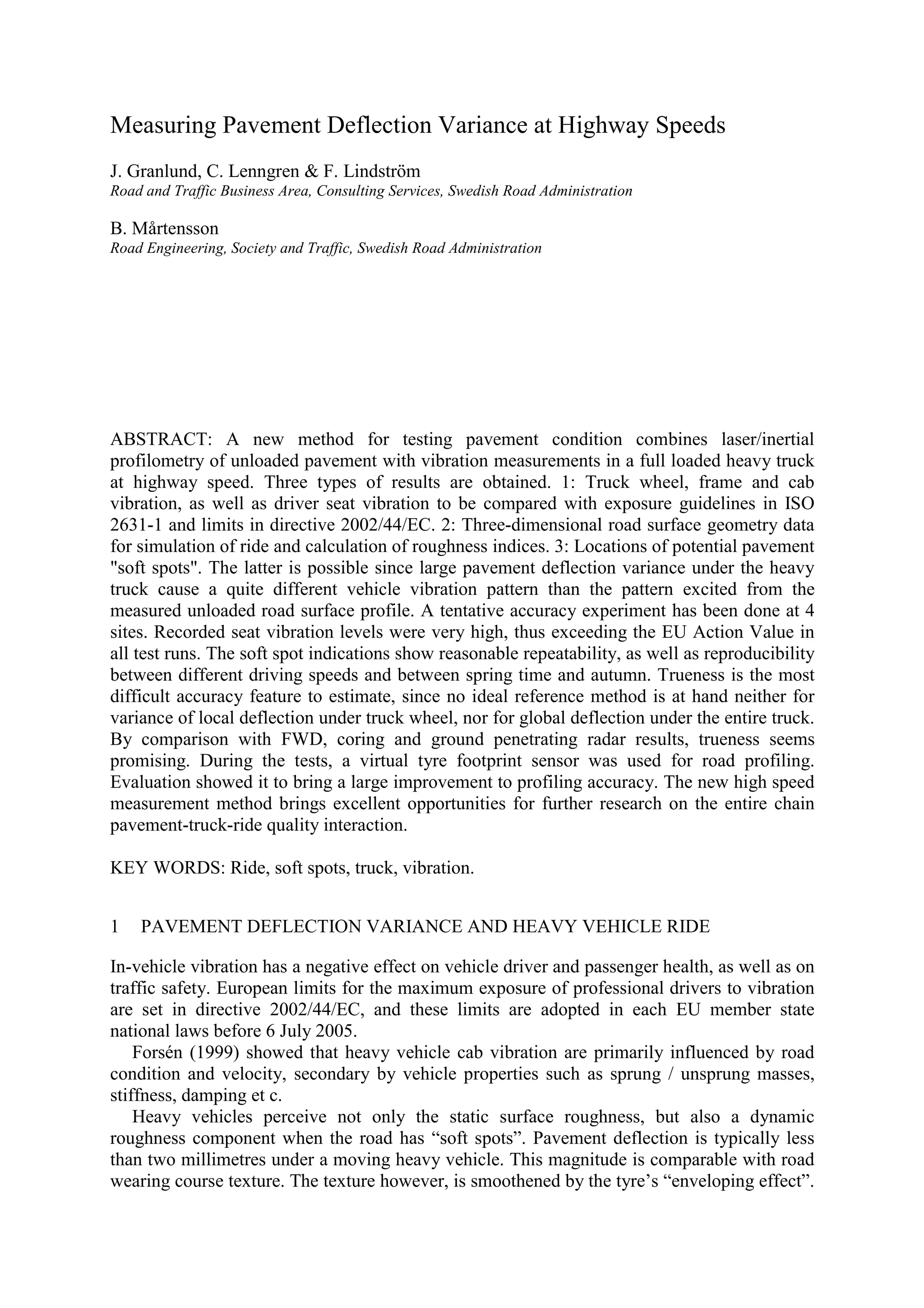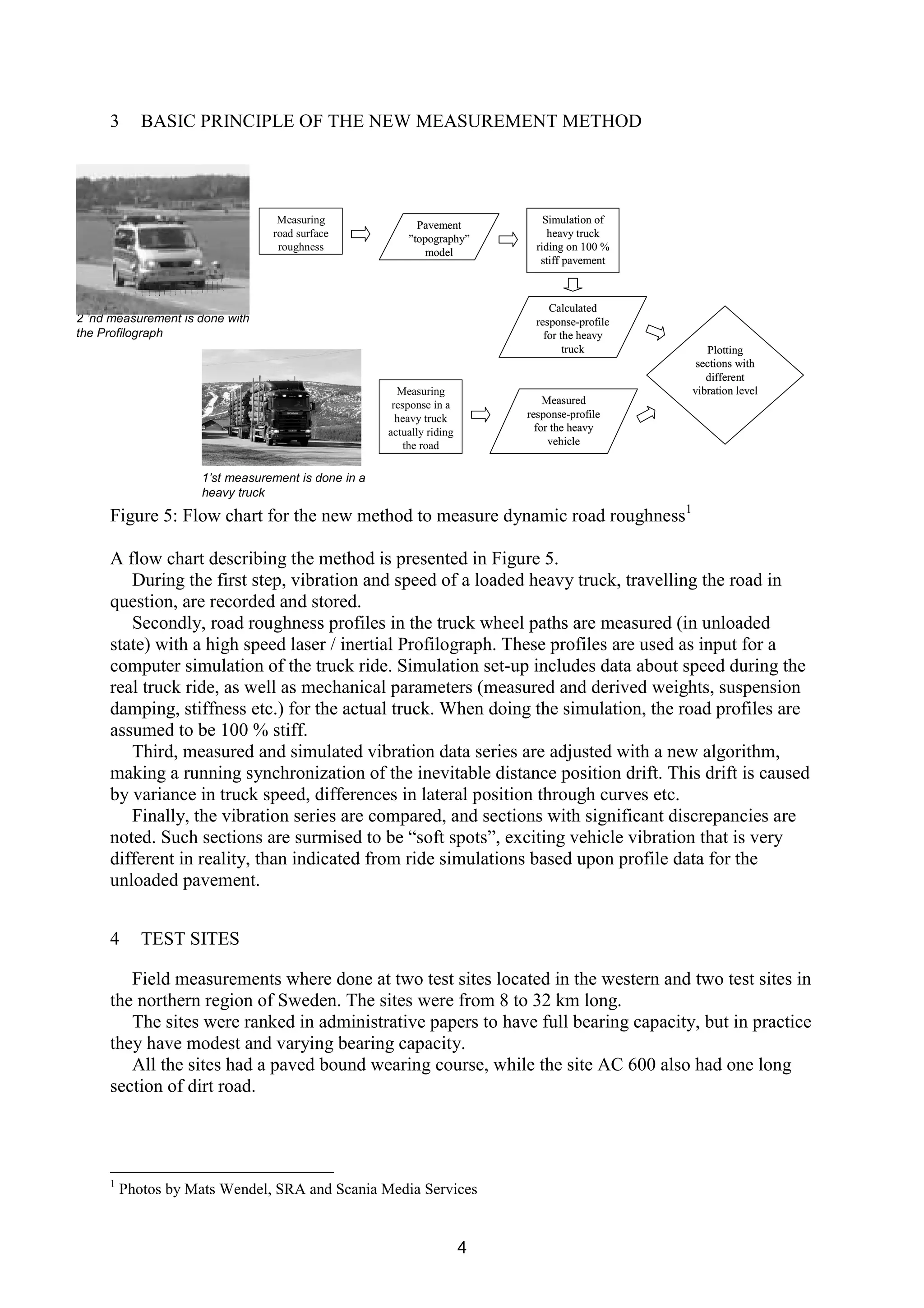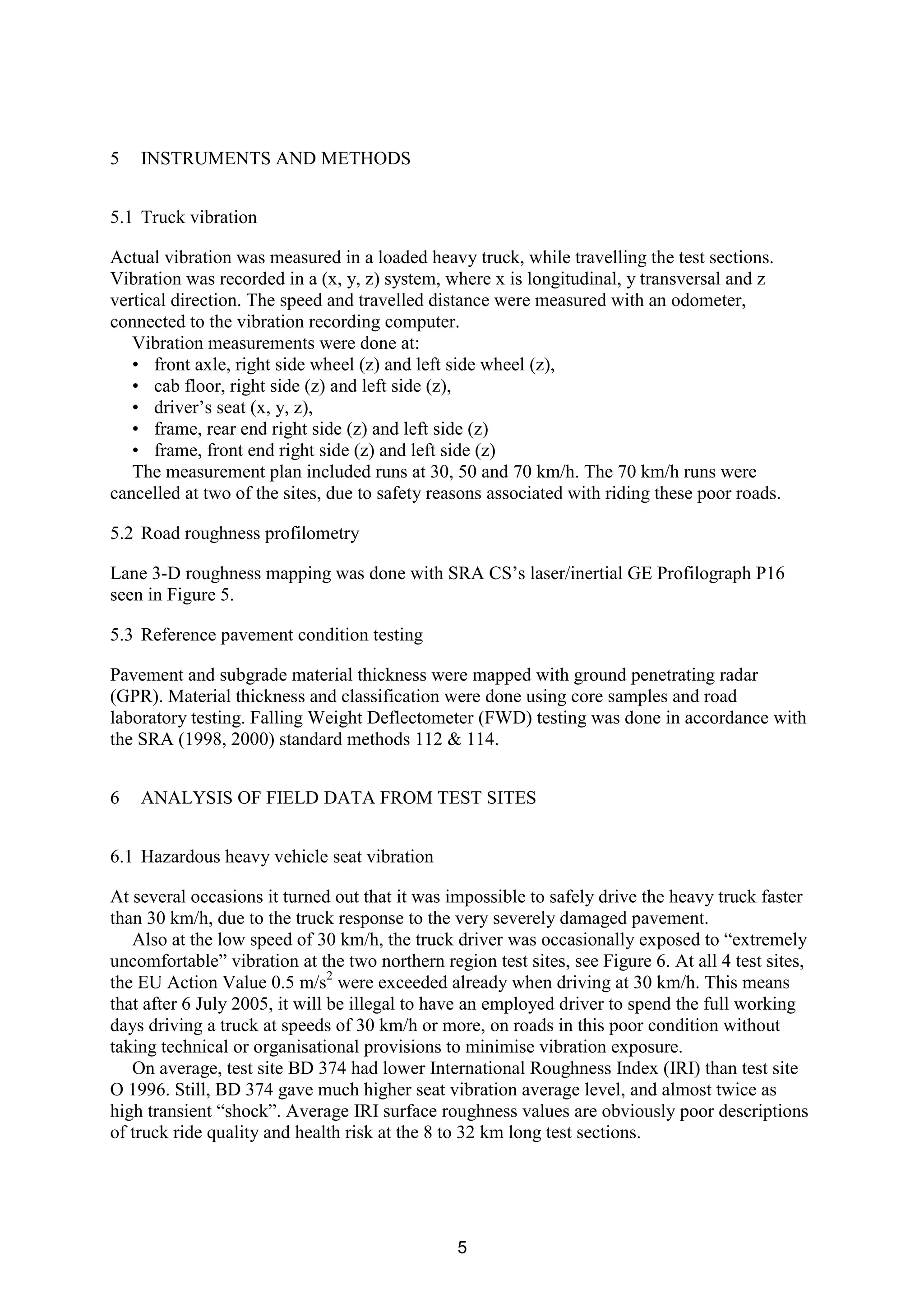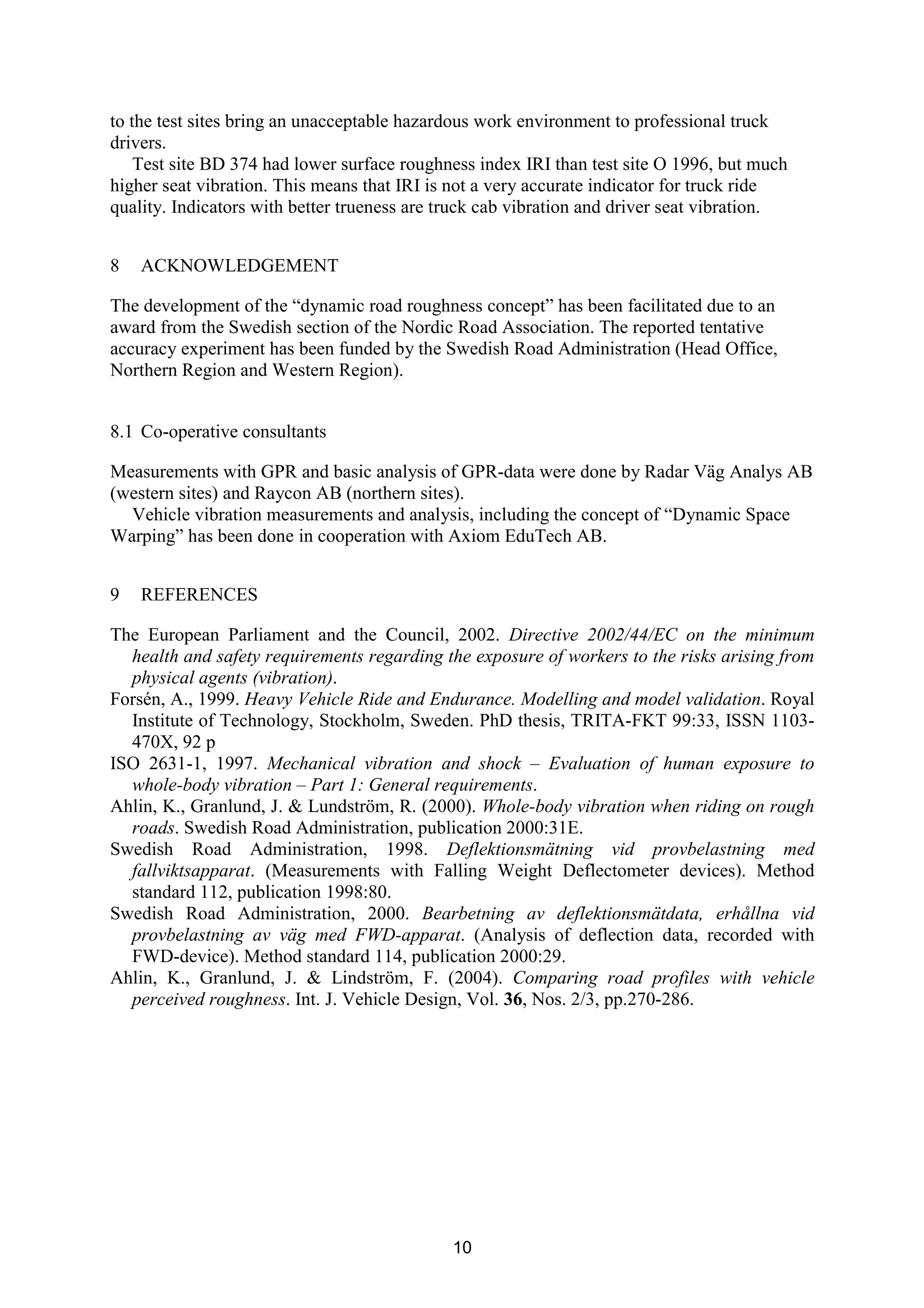The document presents a new method for testing pavement conditions using laser/inertial profilometry and vibration measurements in loaded trucks at highway speeds, resulting in data on truck vibrations, road surface geometry, and potential soft spots in the pavement. The study finds high levels of truck seat vibration exceeding EU action values and highlights the influence of pavement deflection variance on vehicle ride quality. A tentative accuracy experiment at four test sites shows reasonable repeatability and reproducibility of soft spot indications, although challenges with trueness due to lack of ideal reference methods are noted.

![2
The mentioned two mm is smaller than typical road roughness amplitudes. So, when
comparing to static profile heights, ride quality impact of deflections seems neglectable. But
is this really true?
The ISO 2631-1 (1997) standard for evaluation of human exposure to vibration tells that
ride comfort is associated with vehicle cab motion in terms of vibration acceleration and
vibration velocity, rather than vibration displacement. This makes sense; otherwise a stiff
sports car would be considered more comfortable than a soft luxury car when riding on
bumpy roads.
As seen in Figure 1, the time domain vehicle vertical vibration acceleration is associated
with space domain excitation from road roughness profile slope variance, rather than
roughness profile height. Of course speed and suspension properties contribute due to
attenuation or amplification, but the basic excitation follows the relations given in Figure 1.
Figure 1: Relating road roughness to vehicle vertical vibration during ride1
So, even if pavement deflection under heavy vehicles with few exceptions would not be
larger than about one or two millimetres, significant vehicle vibration acceleration may occur
if the deflection profile varies rapidly in terms of large slope variance.
Ahlin, et al. (2000) made an unexpected observation when comparing road roughness with
ride vibration in ambulances and heavy trucks. As can be seen in Figure 2, when surface
roughness drops to zero, significant seat vibration remains in heavy trucks while stretcher
vibration drops to almost zero in ambulance cars. In the trucks, the threshold of the weighted
vibration acceleration was as high as 0.2 m/s2
rms. This value is to be compared with the
Action Value of 0.5 m/s2
rms over 8 hours, stated in directive 2002/44/EC. Clearly, other
factors than road surface roughness can bring as much as 0.2 / 0.5 = 40 % of the allowed truck
seat vibration.
Some possible causal factors behind the 0.2 m/s2
threshold truck vibration in Figure 2 are
wind load, excentric tyre stiffness, heterogeneous tyre/rim geometry, combustion pulses from
the powerful truck engine and unbalance in the power train. However, the hypothesis in this
study states that the 0.2 m/s2
rms threshold partially relates to pavement deflection profile
slope variance (dynamic roughness; soft spots).
1
Photo from SRA publication 2000:31E
Roughness geometry Vertical motions during ride
Level, depth, height [mm]
Slope from hollow to ridge [mm/m]
Slope variance [mm/m2]
Displacement, height [mm]
Vibration velocity [mm/s]
Vibration acceleration [mm/s2], [m/s2]](https://image.slidesharecdn.com/measuringpavementdeflectionvarianceathighwayspeeds-171203201839/75/Measuring-pavement-deflection-variance-at-highway-speeds-2-2048.jpg)
![3
Figure 2: Relation between surface roughness and ride quality domain vibration.
Soft spots and other dynamic roughness under heavy vehicles are expected where:
• the pavement bearing capacity is poor,
• subgrade stiffness changes drastically from soft soil to solid rock et c,
• blocks have due to frost activities moved up to just beneath the asphalt course,
• spring thaw bring large pore water pressures inside the pavement, thereby reducing the
inter-particle friction and effective stress,
• the asphalt bound top layers are severely cracked.
2 OBJECTIVES
The paper objective is to present results from a tentative accuracy experiment with the new
pavement condition measurement method.
One objective in the accuracy experiment was to test the hypothesis that previously
observed threshold truck cab vibration partially relate to pavement deflection profile slope
variance (dynamic roughness; soft spots).
If the patented soft spot measurement method turns out to have enough trueness and
precision, the only equipment needed would be a heavy truck with full payload, instrumented
with a laser/inertial profilometry system.
A major risk factor for the development of the new measurement method is that the
profiling method, or the vehicle simulation models, might not be accurate enough. That would
affect correlation quality significantly. If this would be the case, such a finding would
pinpoint an urgent need for better profiling practices and/or vehicle simulation models also in
order to perform traditional road surface condition assessment. Thus, regardless the risk of not
succeeding with the new method, this research will give input to improved pavement
management in total.
Trucks and ambulances
Model for predicting translational vibrations
from International Roughness Index
0.0
0.5
1.0
1.5
2.0
2.5
0 1 2 3 4 5 6 7 8
IRI [mm/m], average during 100m
MICU ambulance, 120 km/h Emergency ambulance, 90 km/h
New Truck + Trailer, unloaded, 75 km/h Old Truck + Trailer, unloaded, 75 km/h
"The Golden Car" (only z-direction) A little uncomfortable
Fairly uncomfortable Uncomfortable
Very uncomfortable Extremely uncomfortable](https://image.slidesharecdn.com/measuringpavementdeflectionvarianceathighwayspeeds-171203201839/75/Measuring-pavement-deflection-variance-at-highway-speeds-3-2048.jpg)


![6
Figure 6: Site average surface roughness (IRI) and vibration level on truck driver’s seat
6.2 Comparison of measured and simulated truck vibration
In order to minimize influence on the comparison from other vibration sources than from the
road, the receiving point should be as close to the road as possible. The first receiver is the
tyre footprint, but its vibration is very difficult to measure. A more reasonable receiving point
can be found at the unsprung mass rigid parts. It is reasonable that its vibration should be very
little affected by wind load, engine combustion pulses, power train unbalance etc. Thus, the
unsprung mass (the strut) was selected as reference receiving point, where measured and
simulated vibration becomes compared.
The simulation was made with a quarter vehicle model. The truck parameters were
determined by applying the least-square method on the difference between measured and
modelled transmissibility, i.e. the quotient between Power Spectral Density (PSD) for truck
wheel vibration and PSD for road profile. Details are given in Ahlin et al (2004).
Laser/inertial profilometers typically record 1 mm wide profiles. Such a narrow profile
does not give ideal fit with 3 - 4 dm wide truck tyre footprint perceived roughness. To
overcome this problem, a virtual tyre footprint profile sensor was used in this project. The
accuracy of the profile, as evaluated in terms of vehicle perceived roughness, was improved
with about 10 to 15 % compared to a normal profilometer recorded profile, see Ahlin et al
(2004).
At first glance, simulated and real vibration showed very poor likeness. As expected, this
was due to the small but unavoidable differences in position of the data series. These
differences originate from speed variation in the real truck, and from different lateral
positioning through horizontal curves etc.
The positioning problem was solved by using a tailored algorithm for “Dynamic Space
Warping”. The warping makes it possible to adjust the two vibration series extremely
carefully to each other, not to loose correlation in position with more than a number of
decimetres.
0.73
0.56
0.85
0.74
2.31
2.24
1.70
1.14
4.34
4.13
5.50
3.95
0
0.5
1
1.5
2
2.5
O 2183 O 1996 AC 600 BD 374
Test site
RMSofweightedvibration
acceleration[m/s2
]
0
1
2
3
4
5
6
IRI[mm/m]
Average level Max level (over 1 s) IRI average value
Seat vibration @ 30 km/h
IRI = 3,95 mm/m was much worse than IRI = 4,13 mm/m
2002/44/EC:
Action Value A(8)
= 0,5 m/s2
2002/44/EC:
Action Value A(8)
= 0,5 m/s2
ISO 2631-1(1997):
”Extremely
uncomfortable” = 2 m/s2
ISO 2631-1(1997):
”Extremely
uncomfortable” = 2 m/s2](https://image.slidesharecdn.com/measuringpavementdeflectionvarianceathighwayspeeds-171203201839/75/Measuring-pavement-deflection-variance-at-highway-speeds-6-2048.jpg)
![7
Examples of resulting likeness between the two wheel-vibration series are shown in Figure
7. The graphs show reasonable overall likeness, while some sections show significant lower
likeness. Such sections potentially have large pavement deflection variance.
O 2183, Dals Ed - Nössemark. 3 runs at 30 km/h
0%
10%
20%
30%
40%
50%
60%
70%
80%
90%
100%
200 400 600 800 1000 1200 1400 1600 1800 2000
Distance [m]
Simulatedandmeasuredwheelvibrationlikeness
Run 1
Run 2
Run 3
Figure 7: Repeatability results for three truck runs, test site O 2183
Where the warping has worked as intended, accuracy is as described from the examples
below. However, at some sections, the warping has gone “out of the track”. The algorithm has
been continuously improved during the project, but it is not perfected yet. Thus, an upcoming
development work is perfecting the warping algorithm.
The method repeatability is reasonable; the 3 runs in top of Figure 7 show 4.2 % average
standard deviation.
Reproducibility over time is reasonable as well; spring and autumn runs at site BD 374
showed 4.8 % average standard deviation. Certain deviation is due to the thaw process,
whereas likeness is lower during the spring time. Thus, the method may be useful for
detection of spring thaw related pavement problems?
Reproducibility between different speeds also seems reasonable; four 5 km long runs at 30
and 50 km/h recorded at test site AC 600 show 3.7 % average standard deviation. At different
speeds, the interaction between pavement structure (resonances with soil layers
eigenfrequencies and so on), surface and vehicle dynamics become different. This explains
deviations and must be recognized when drafting the final test method. This knowledge could
perhaps become utilized to measure pavement dynamic properties in more detail, by
comparing results from runs at different driving speeds.
6.3 Comparison of potential soft spots with ground penetrating radar (GPR) results
The truck wheel vibration likeness varied between 3 and 40 % for section 4700 to 5000 m at
test site AC 600. By georadargram, the pavement layers were revealed as thin and having
large thickness variance. Between 4760 and 4840 m, the pavement layers show poor integrity
at depths below 0.2 m, likely due to frost fatigue.](https://image.slidesharecdn.com/measuringpavementdeflectionvarianceathighwayspeeds-171203201839/75/Measuring-pavement-deflection-variance-at-highway-speeds-7-2048.jpg)
![8
Similar agreements were found at many, but not all, identified potential soft spots. Also
when comparing GPR results with FWD testing, the agreement on sections with structural
problems was not totally uniform. This confirms the complex nature of pavement engineering,
and different pavement test methods should be seen as valuable complements to each other
and to the engineer’s visual inspection, when making a pavement condition assessment.
6.4 Comparison of potential soft spots with core samples
Core sampling was not done intensively enough to support any stronger conclusions. At site
AC 600, 15 cores were taken. Average total pavement thickness was 35 cm. Average wheel
vibration likeness was 70 % among sections where coring showed 35 cm or thicker pavement.
The likeness was only 50 % among sections with less than 35 cm thickness. This indicates
that pavement deflection variance is likely to be larger at sections with thinner pavement
thickness, which makes sense.
6.5 Comparison of potential soft spots with results from FWD evaluation
The FWD analysis was done in accordance with the SRA evaluation standard method 114
(2000).
During the spring thaw period FWD-test, large deflections and deflection variance were
observed in the data recorded. FWD centre deflections of up to over 4 mm was observed at
dirt road sections, and over 2 mm at paved sections. Centre deflections varied up to 3.6 mm
between adjacent samples at dirt road sections, and up to 1.5 mm at paved sections.
Potential soft spots are identified by lower-than-usual likeness between simulated and
measured wheel vibration.
Examples of agreement between potential soft spots and FWD results are showed in Figure
8 and Figure 9. As seen in Figure 8, wheel vibration likeness shows reasonable fit with
calculated subgrade E-module. Bearing Capacity Index is defined in SRA method 114. In
Figure 9, this index shows a reasonable fit with wheel vibration likeness.
AC 600, Östra Strömåker
10
100
1000
7250 7450 7650 7850 8050 8250
Distance [m]
LogEu[MPa]
0%
10%
20%
30%
40%
50%
60%
70%
80%
90%
100%
Truckwheelvibrationlikeness
Eu min, springtime Wheel vibration likeness
Figure 8: Subgrade stiffness versus soft spot identifications](https://image.slidesharecdn.com/measuringpavementdeflectionvarianceathighwayspeeds-171203201839/75/Measuring-pavement-deflection-variance-at-highway-speeds-8-2048.jpg)
![9
BD 374, Norr Storfors
1
10
2100 2200 2300 2400 2500 2600 2700 2800 2900 3000
Distance [m]
BearingCapacityIndex
asperVVMB114(Log-scale)
0%
10%
20%
30%
40%
50%
60%
70%
80%
90%
100%
Truckwheelvibrationlikeness
Springtime Index Autumn Index Wheel vibration likeness
Figure 9: Bearing capacity index versus soft spot identifications
7 CONCLUSIONS
Results from the accuracy experiment do not support a rejection of the hypothesis; previously
observed threshold truck cab vibration is partially related to pavement deflection profile slope
variance (dynamic roughness; soft spots). Thus, the new and patented method shows a
potential for measuring pavement deflection variance at highway speed with existing profiling
equipment.
The most studied test site, BD 374, yielded an average likeness of 85.3 % between real and
calculated heavy vehicle vibration. At some sections, the collated vibration data show very
poor likeness. Such sections are presumed to have high pavement deflection variance.
The likeness increased much when using road profile data collected with a virtual tyre
footprint profile sensor instead of a single laser sensor, see Ahlin et al (2004).
Repeated truck runs show reasonable precision in likeness between simulated and
measured wheel vibration.
Reproduced runs at spring time and autumn also show reasonable likeness precision, with a
bias where spring time likeness is significant lower at certain sections. Those sections are
presumed to have spring thaw related problems. Reproduced runs at different speeds also
show reasonable precision.
Comparison with results from traditional pavement condition tests (FWD, GPR and coring)
show promising trueness. Soft spot indications have been correlated reasonably well with
subgrade stiffness as well as with Bearing Capacity Index.
The next step to come is perfecting the warping algorithm, used for dynamic space domain
adjustment of simulated and measured vibration series. After that, a standard method should
be formalized, and its performance evaluated in a new accuracy experiment.
Truck driver’s vibration exposure already at 30 km/h exceeded the new EU Action Value
at all test runs. At the roughest (northern region) sites, the ride occasionally became
“extremely uncomfortable” already at 30 km/h. This shows that roads with condition similar](https://image.slidesharecdn.com/measuringpavementdeflectionvarianceathighwayspeeds-171203201839/75/Measuring-pavement-deflection-variance-at-highway-speeds-9-2048.jpg)
